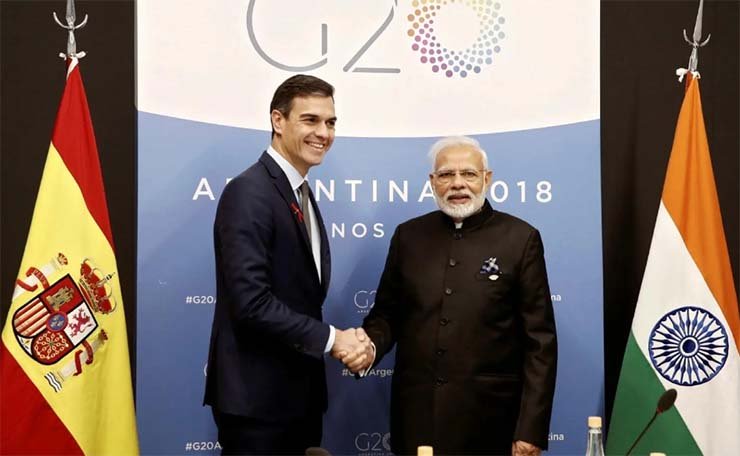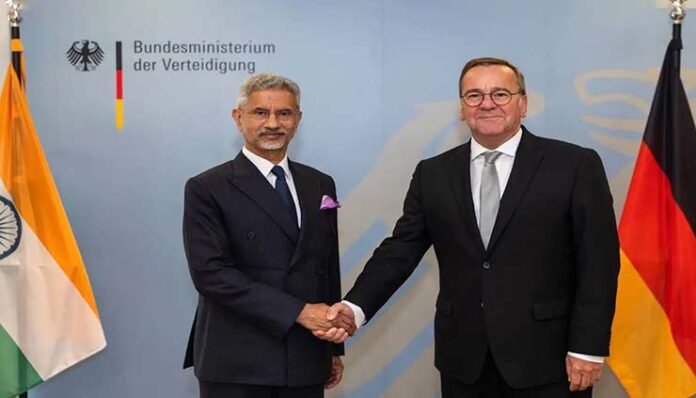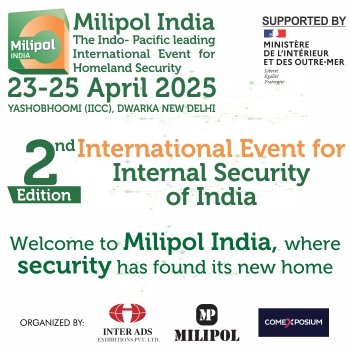In the last week of October, India witnessed two prominent European leaders’ back-to back visits; one, from Germany and another from Spain with both focusing on strengthening defence ties with New Delhi at the time when China is keen to change status quo in the Indo-Pacific region, especially in the Taiwan Strait and the South China Sea.
The just concluded visit of President Pedro Sanchez, the first by a Spanish head of government in nearly two decades, led to the joint inauguration along with Prime Minister Narendra Modi of the Tata Aircraft Complex in Vadodara, which will be producing as many as 40 C-295 military transport aircraft that is armed with capacity to carry up to 71 troops or 50 paratroopers.
At the same time, the three-day visit of German Chancellor Olaf Scholz to India imparted a fresh momentum to defence partnership between the two countries, with both “declaring joint intent to conclude a Memorandum of Arrangement on mutual logistics support and exchange between Indian armed forces and Germany to further intensify defence and security ties and to establish a basis for provision of mutual logistics support including in the Indo-Pacific theatre.” reads the India-Germany joint statement on the occasion.
Watershed Moment in ‘Make in India’ Initiative
Significantly, both Spain and Germany want to jointly produce defence technologies with India under ‘Make in India’ initiative. In this context, Spain’s decision to manufacture 40 C-295 military transport aircraft in India is considered as the beginning in its effort to align with New Delhi’s strategic aim to reduce long-term dependency on foreign suppliers for defence-related equipment.
The just concluded visit of President Pedro Sanchez, led to the joint inauguration along with Prime Minister Narendra Modi of the Tata Aircraft Complex in Vadodara, which will be producing as many as 40 C-295 military transport aircraft that is armed with capacity to carry up to 71 troops or 50 paratroopers
“Both leaders (PM Modi and Spanish President Sanchez) expressed satisfaction on the progress made in the C-295 aircraft project as a symbol of the growing defence industrial cooperation between the two countries. In line with this growing partnership, and in recognition of the advanced capabilities and competitiveness of the Spanish defence industry and its contribution to the goals of the ‘Make in India’ initiative, they encouraged their respective defence industries in other verticals to set-up similar joint projects in India.” the India-Spain joint statement declared.
Manufactured by Airbus, the C-295 transport aircraft will add to the strength of the Indian Air Force as it has several high-tech features, including ability to operate from short and unpaved runways, thus, making it extremely suitable to operations related to tactical transport, medical evacuation, and surveillance.
For India, while it is considered as a major stride in the country’s strategy of self-reliance in defence technology, the Vadodara-based Tata Aircraft Complex will also serve as the final assembly line plant for C-295 aircraft, and there is also a willingness on the part of Germany to join India in the research and development of cutting-edge defence technologies. This was manifest in the joint statement issued after the 7th India-Germany InterGovernmental Consultations held between Prime Minister Modi and German Chancellor Olaf Scholz on October 25.
“Both sides (India and Germany) committed to supporting strategic exports to India and encouraged co-development, co-production and joint research between the respective defence industries.” the India-Germany joint statement declared.
The three-day visit of German Chancellor Olaf Scholz to India imparted a fresh momentum to defence partnership between the two countries, with both “declaring joint intent to conclude a Memorandum of Arrangement on mutual logistics support and exchange between Indian armed forces and Germany to further intensify defence and security ties and to establish a basis for provision of mutual logistics support including in the Indo-Pacific theatre.”
India and Germany have already established a high-level defence committee (HDC) dedicated to promoting collaborative efforts in the defence sector. Notably, India and Germany are conducting negotiations for constructing six advanced submarines equipped with proven air-independent propulsion (AIP) systems under P751 Project. Three years ago, Germany’s Thyssenkrupp Marine System (TKMS) had withdrawn from this project.
The reason for its withdrawal was India’s demand for the full transfer of technology for submarine—from design to development, TKMS is undergoing a restructuring process and facing opposition from Germany’s Green Party. However, in the changed situation, Berlin is itself pushing the submarine deal. That is why the issue was on the table during the German Chancellor’s visit.
“There is a project(P751) that is underway, where the Ministry of Defence is involved in an exercise to assess competing offers for the submarines that India wishes to procure…Obviously, yes, the German side is interested in this issue and there was reference made on this.” Foreign Secretary Vikram Misri said during a special briefing on October 25.
Spain is also in the race for P751 Project. The country’s Navantia group is eyeing to bag the contract for constructing six submarines with AIP systems. Navantia has partnered with L&T for P751 Project, showcasing its AIP system, which has been successfully tested by the Spanish Navy.

Challenges of Indo-Pacific and India’s Strategy
India’s enhanced defence engagements with Germany and Spain have witnessed a marked shift, given the rising tension in the Indo-Pacific region because of China’s aggressive behaviour.
For example, Germany has agreed to permanently deploy a Liaison Officer at the Gurgaon-based Information Fusion Centre to monitor marine traffic in the Indian Ocean Region. Established in 2018, the Information Fusion Centre currently hosts Liaison Officers from 12 countries, including from the Quad.
Spain is also in the race for P751 Project. The country’s Navantia group is eyeing to bag the contract for constructing six submarines with AIP systems. Navantia has partnered with L&T for P751 Project, showcasing its AIP system, which has been successfully tested by the Spanish Navy
On the other hand, exemplifying growing defence and strategic engagement between India and Germany in the Indo-Pacific region, the German air force joined India-held first multinational air exercise ‘Tarang Shakti’ in August this year. German navy’s frigate “Baden-Württemberg” along with the combat support ship “Frankfurt Am Main” conducted drills with the Indian Navy ships during their port call at Goa’s Mormugao Port on October 26.
Spain, which supports freedom of navigation in the South China Sea, has underlined the need for Madrid and New Delhi to contribute significantly in building an Indo-Pacific region that is open and secure. The Spanish President admitted, during a programme organised by the Observer Research Foundation in Mumbai, that the world’s centre of power has shifted towards Asia where India plays a key role.
Undoubtedly, India wants to enhance its strategic footprint in the region, which cannot be achieved without strengthening its partnership with like-minded countries. Spain and Germany have joined the list of nations like Australia, France, Japan, and the US which together with India are impacting the Indo-Pacific region in terms of its development, security, and stability.
India, Japan, Australia and the US, under their Quad initiative, have already increased engagement throughout the region to bolster maritime security, improve maritime domain awareness and uphold a free and open Indo-Pacific.
Besides, to improve interoperability in the Indo-Pacific, the Indian Coast Guard, the US Coast Guard, the Japan Coast Guard, and the Australian Border Force have planned to launch a first ever Quad-at-Sea Ship Observer Mission in 2025.
Undoubtedly, India wants to enhance its strategic footprint in the region, which cannot be achieved without strengthening its partnership with like-minded countries. Spain and Germany have joined the list of nations like Australia, France, Japan, and the US which together with India are impacting the Indo-Pacific region in terms of its development, security, and stability
India’s Immediate and Long-term Priorities
India’s immediate and long-term plans are to enhance the strength of its defence sector to meet its security needs and broaden its market presence in the world. To this regard, while it promotes indigenisation, it has also entered collaborations with countries, largely from the West, to produce cutting-edge defence equipment under the technology transfer programme.
According to VK Saraswat, ex-DRDO Chief and current member of NITI Aayog, India presently produces 60% of its arms and ammunition domestically. On the other hand, in its report titled “India Defence,” Nomura, Japan’s largest investment bank and brokerage group has projected India’s defence capital expenditure reaching close to 37% of the total budget by Financial Year 2030.
Overall, the back-to-back visits by the German Chancellor and the Spanish President highlight growing importance of India, which wants to revamp defence relations with the western countries by strategically aligning with them under the technology transfer programme. It is estimated that between 2024 and 2032, India will import nearly $138 billion worth of equipment to fulfil its defence requirements. All this while, it will lay a substantial focus on collaboration with foreign companies for joint research and production of cutting-edge defence products.
–The writer is a senior journalist with wide experience in covering international affairs. The views expressed are of the writer and do not necessarily reflect the views of Raksha Anirveda










